AUP-272
Organização
urbana e planejamento
2° semestre
de 2005
Csaba Deák | Nuno
Fonseca | Maria Lúcia Martins | Pedro Taddei | João
Whitaker
Monografia individual
apresentada à disciplina
de AUP 272
Novembro 2005
Transportation
in São Paulo
for residents and visitors
Bo Kristiaan Janssen
Novembre 2005

Content
Introduction
Public Transport
Individual
Transport
Conclusion
Sources
Introduction
A lot of people
asked me, before leaving to São
Paulo and during my stay
there, why I chose to study in São Paulo.
Time after time I ended up telling them the
same story: I did not want to stay in Europe nor a
other western country, my dad is a Portuguese translator and so I am
naturally
more interested in learning the Portuguese language and as final, I
always
wanted to go to Brazil partly because of it's famous Niemeyer architecture.
The reply was in
most cases: 'ok, but why São
Paulo?'. My answer is that
it was simply the city with the only university
where my university in The Netherlands has contact with. This was also
the only
reason, I did not know anything about the city. My only image of São Paulo
was a commercial I saw on internet with a helicopter
in it flying over the big buildings, that the city has 20 million
inhabitants
and that it is extremely dangerous and violent. The last point is one I
never
really took serious, I mean that I never saw it as a reason not to go.
There
are still 20 million people who have to live in this 'extremely
dangerous'
city. The fact is that people outside Brazil,
or better said the people in The Netherlands,
don't know São Paulo. Most
people will not be able to point the location of one of the largest
cities in
the world, or even know in which country it is. Friends asked me if I
had to learn
Spanish, friends who all study at very renowned university's in The
Netherlands.
After my admittance
to USP I started my small research to get to know São Paulo
better.
My first sources
were the dutch students who studied at USP before. They told me some
stories
and showed me some pictures. It was supposed to be the 'motor' of Brazil,
a working city. My impression was that I was
going to a very poor and not modern city, although I knew there was a
metro and
a lot of big buildings.
I also started to
look on Internet. The first thing I noticed that it was very hard to
find
English written websites, this turned out to be a problem as I still
couldn't
read Portuguese. This meant that I didn't get to know much more from São Paulo
from the Internet. Because I already started
to search for an apartment and I didn't know where to live, I also
looked for a
decent map, but the only map I could find was one for the metro. I
noted that
it was very strange for a big city not having a map on Internet to get
an
overall view.
Finally FAAP, a
private university where I attended an intensive Portuguese course
during the
first month, helped me out in finding an apartment. This apartment is
located
in the neighbourhood Higienópolis which was the startpoint of my
exploration of São
Paulo.
***
São Paulo
is
not very known in The Netherlands, and I think this is the same in most
'western' countries. The image of São Paulo
is not very good with the people who do know
the city, the overall image is that it's a very dangerous and not a
good city
to be in. The possibilities of information retrieval were not able to
change that
image for me. So I went to São
Paulo with the idea of
going to one of the worst places I could imagine, one
big adventure and clearly not the 'western' place I did not wanted to
go.
This is a quite
strange situation for a city who wants to be a modern and forward going
city,
it's not reflecting this outside Brazil
or maybe better said, outside South-America. Why
is São Paulo not known as a place to visit?
In the last few
months I noticed that São
Paulo is a city where
there is no centre. There is an historically located
centre, but this isn't functioning as one. There are multiple
economical,
shopping and entertainment centres spread over the city. One of the
reasons is
a lack of planning during the explosive grow in the last century. The
city
exploded, as seen in the graphics.
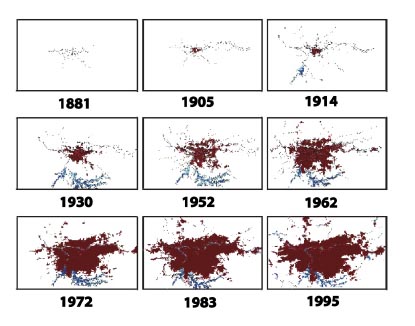
Modified graphics
Original from Csaba
Deák in Strategic planning & urban projects/ Responses to
globalisation
from 15 cities, 2001
This extensive
growth has resulted in a literally exploded city. This means that it is
very
hard for a visitor, who doesn't know the city, to discover the places
where
they need to be and where they can have fun.
What is in the
history you can't turn back, so the city has to deal with this fact.
But
because of the great distances in a city this big, this is not easy.
You need
to have a good transport system to make an attractive city for visitors
and
make the city functional for the people who have to life and work here.
As the
city is 'the motor' of Brazil,
it needs to function as a motor.
In this
'monografia' I want to concentrate myself on the functionality of this
transport system, for residents of São Paulo
and his visitors, on a small and more large
scale in this city. I will do this from my point of view, because I
have and am
experiencing both situations.
Does the transport
system function for both visitors and residents of São
Paulo.
Public transport
Metro
The construction of
the first line, north-south Tucuruvi-Jabaquara, started in 1968 and
opened in
1974. This day there are 6 lines functioning. There are 2,7 million
users a day
on a total length of 270 kilometres, in the complete metropolitan São Paulo.
São Paulo city has 102,4 kilometres of metro. With 10,2
passengers per kilometre per year it is the most intensively used
system of the
world after New York.
Currently there are
3 projects running for 2 new lines and one extention, see also the map.
The Metro system in São Paulo
is one of great distances. You can overlap
great distances and you can get the conclusion that you're still from
great
distance of your target destination. With an avarage of 1,1 kilometre
between
the seperate stations you will be needed to walk or to choose another
form of
transport to arrive at your final destination.
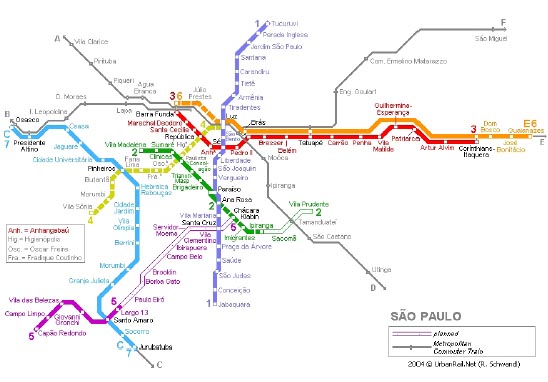
Public Transport
Verkeerskund,
urbanrail.net
 The São Paulo
metro is not very economical. For example: When
you want to go from the neighbourhood Higienópolis to Paulista Avenue, it is faster to walk then to go by metro. Although
it looks fast on the map. The São Paulo
metro is not very economical. For example: When
you want to go from the neighbourhood Higienópolis to Paulista Avenue, it is faster to walk then to go by metro. Although
it looks fast on the map.
As first you will have
to walk to the station
Marechal Deodoro (or Santa Cecilia, there is no big difference in
distance) to
talk the metro to the transfer station Sé. Here you take line 1,
to Jabaquara.
At Paraíso you transfer to line 2, to Vila Madalena. Finally you
will arrive at
Trianon-Masp after spending in total 45 minutes of travelling. If you
need to
walk after that it will take you at least 1 hour before you will arrive
at you
destination. Walking takes you maximum the same amount of time.
In the map is the
walking route in orange, the red, blue and green are the different
metro lines.
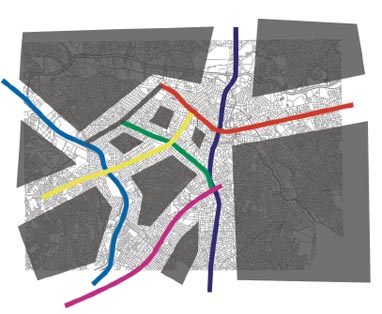 We will project
these findings on a larger scale in São Paulo.
The coloured lines are the metro lines
existing now and planned for the future. The gray spots are actually
'black'
spots because it are areas where you are to far to access the metro so
it
becomes not an option for travelling. The big gray spots north-west and
south-east
are the areas where there is a big problem in accessing the metro, they
actually don't have one. We will project
these findings on a larger scale in São Paulo.
The coloured lines are the metro lines
existing now and planned for the future. The gray spots are actually
'black'
spots because it are areas where you are to far to access the metro so
it
becomes not an option for travelling. The big gray spots north-west and
south-east
are the areas where there is a big problem in accessing the metro, they
actually don't have one.
A metro-system is one of the best
solutions
for fast transport in big city's, almost every with big proportion use
this
system. But in this case it has only use when you are living near or
have to travel
big distances.
Because of the easy
to use and safety in the metro it is a nice transportation device for
visitors
to São Paulo. There are no traffic problems, it is not
expensive and most stations are located near places which are worth
visiting.
Bus
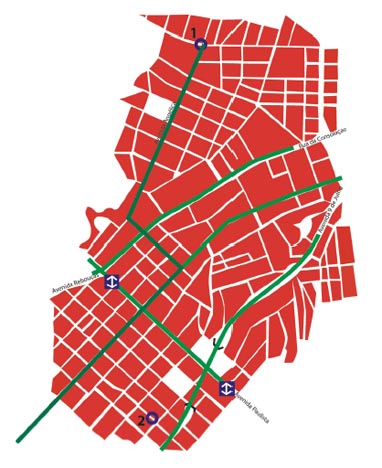 The bus (ônibus)
system of São Paulo is
not very easy to use. It is quite hard to get around if you don't know
how the
buses are driving. The boards on the side of the buses say the main
streets but
as soon as you want to go to a location where there is no direct bus
going to
it is hard to find out how you are going there. Also in this case you
will end
up walking for quite a distance. The bus (ônibus)
system of São Paulo is
not very easy to use. It is quite hard to get around if you don't know
how the
buses are driving. The boards on the side of the buses say the main
streets but
as soon as you want to go to a location where there is no direct bus
going to
it is hard to find out how you are going there. Also in this case you
will end
up walking for quite a distance.
For example:
In my case I live
at Avenida Angélica in Higienópolis and friends of me
live at Alameda Franca in
Jardim Paulista. In this case I would like to get there by bus. The
problem is
that there are a lot of buses going throe Avenida 9 de Julho, close to
there
home, but those buses are not coming near to my home. The closest one
is going
throe Rua Augusta (on the picture dark green). This still is quite a
walk from
the house of my friends. So not really an option. Metro is also not an
option, as
said in 'Metro'.
Conclusion Public
Transport
In this case there
is not directly an easy solution to solve this problem, it's quite a
small
scale. But I think this example is one which represents the problems in
the
planning in São Paulo,
this one is on a small scale but you can pull this to a larger scale
and see
the same problems. The holes which are left by the metro are mostly
being
filled with the bus system. But also there, as you can see on the small
scale,
it isn't flawless. Problems out of the life of inhabitants of São Paulo.
A car is needed.
Individual transport
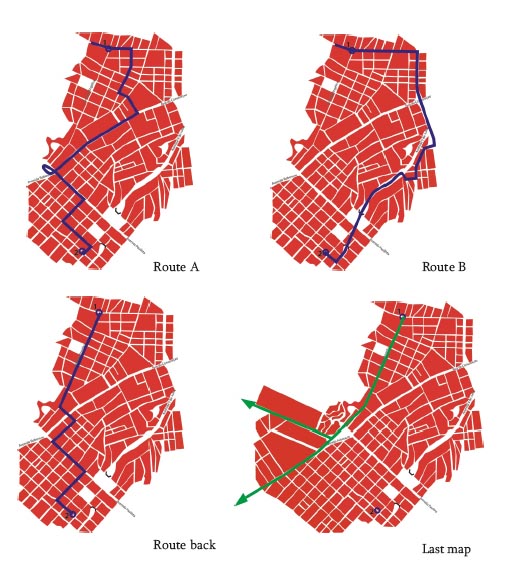 Because I do not
have a car in São
Paulo it
is not easy to give my opinion about the road system in São Paulo.
But I do use the taxi's once in a while and I
have talked with a lot with Brazilians who do have a car and live in São Paulo
for much longer than I do. Because I do not
have a car in São
Paulo it
is not easy to give my opinion about the road system in São Paulo.
But I do use the taxi's once in a while and I
have talked with a lot with Brazilians who do have a car and live in São Paulo
for much longer than I do.
Again I will use
the same example, how to get from point 1 to point 2.
On every map of
this piece of the city you get the idea that you can drive directly
from
Avenida Angélica on to Avenida Paulista. This is not possible
though, what
means that you need to know this situation very well to have the
solution there
before arriving at this big intersection, because before you know it
you are
already on Avenida Rebouças. No returning back.
In my experience
with taxi's (approximately 50 rides) they make a choice out of 2 ways
to get to
point 2, named as 'Route A' and 'Route B'. Both routes are extremely
complicated and not possible for the 'visitor', if you are not living
in the
neighbourhood you will not drive according this route and you will have
a lot
of problems getting to point 2. On the last map are the directions
where the
unexperienced driver will probably be heading without knowing how to
come back.
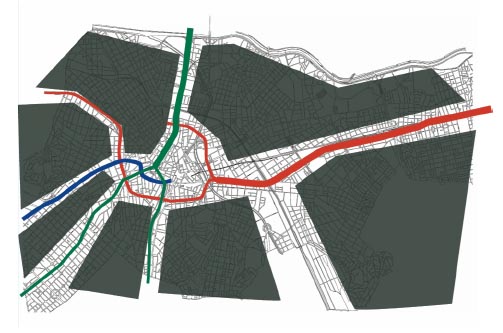 This example is
again a problem on small scale, on larger scale you see the same
problem
happening in the connection of Region East (Zona Leste) with the Centre
and the
immediate region on the west side of it.In this map you can see how the
main
access to the centre is on this moment. The gray zones between the
lines are
zones which are hard to access and it is very hard to move from zone to
zone.
In the current system there is no option to go to the other zone purely
by a
primary road, you will have to drive over secondary and tertiary roads.
This
does not help making the road system clear and easy. This example is
again a problem on small scale, on larger scale you see the same
problem
happening in the connection of Region East (Zona Leste) with the Centre
and the
immediate region on the west side of it.In this map you can see how the
main
access to the centre is on this moment. The gray zones between the
lines are
zones which are hard to access and it is very hard to move from zone to
zone.
In the current system there is no option to go to the other zone purely
by a
primary road, you will have to drive over secondary and tertiary roads.
This
does not help making the road system clear and easy.
Conclusion Individual Transport
As soon as you have
a lot of experience in the traffic in São Paulo
you will manage to get around, and as soon as
you manoeuvre around the trafficjams you will not experience a lot of
problems.
But when you are not a regular in this city, you will have a lot of
problems
finding your way and it will take a lot of time. And as soon you get
lost and
find yourself in a bad area of the city, it can
Conclusion
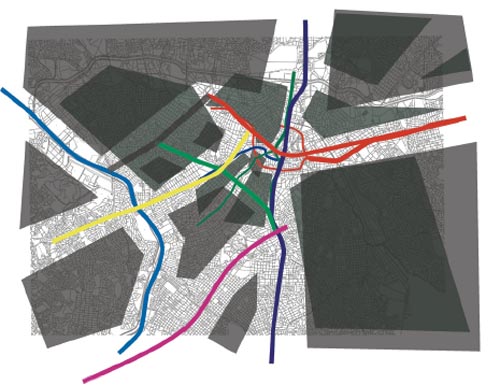 When you put the
both maps, metro and car, of the larger scale together. You will see
the
overlapping gray areas as the spots where it is very hard to get to and
away
from. Espescially the south-east part is a problem area. This area is
mainly
planned for residential use, and is not a part of town where a tourist
would
like to go. When you put the
both maps, metro and car, of the larger scale together. You will see
the
overlapping gray areas as the spots where it is very hard to get to and
away
from. Espescially the south-east part is a problem area. This area is
mainly
planned for residential use, and is not a part of town where a tourist
would
like to go.
But as soon as you
are staying in São
Paulo a
little longer than a few days, you will be needing to get to places
where it is
not easy to get to using only public transport. These moments you will
miss having
a car and the only solution is going by taxi. But this is not a real
solution,
taxi's in São Paulo are
quite expensive for a student, even if they are from Europe, and so not for
every day use.
The conclusion out
of this monografia is that the current transport 'motor' of São Paulo
is not functionizing very well. Residents of São Paulo
do not have an easy time getting around in the
city. The fastest way to get around is by car, but only outside of the
rush
hour. If you do not own a car, your world is a lot smaller, as most of
the
Brazilians do not earn enough to get around by taxi. The reach of the
metro is
to small to get where you are 95 % of your time. Buses take too much
time, your
bus will rarely go straight to your destination without having to walk
far.
Moving around in São Paulo
by car as visitor is very hard. The road
system is not clear and if you find your destination outside of the
main roads
it will take you a lot of time. When you are getting lost you need to
watch out
ending up in a bad area. By taxi the visitor will think he's getting
ripped of
all the time because of the strange shortcuts taxi drivers take to
manage in
the chaos.
By bus is not worth
the struggle for a visitor, as soon as you find out how the system
works you
will be out of São
Paulo
again. The bus is a nice option if the bus goes straight to your
destination. By
Metro is probably the most efficient way to move around in São Paulo,
along the metro track there are a lot of
spots well worth to visit. It is an easy way and a cheap way. As soon
as you need
to be outside of the metro range, a taxi is probably the fastest option
but
also the most expensive one.
Sources
- verkeerskunde
number 2-2005
-
http://www.urbanrail.net/am/spau/sao-paulo.htm, 26-11-2005
- Csaba
Deák, São Paulo, In Carmona,
Marisa & Burgess, Rod
(orgs, 2001)
Strategic planning & urban projects/ Responses to
globalisation from
15 cities Delft University Press, Deft, pp:173-82
(text) & 282-88
(illustrations)
|